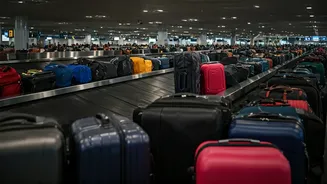Application Decline Noted
Columbia University has reported a decrease in the number of international applications. This decline aligns with broader trends within the US higher education
landscape. Multiple factors are at play, with stricter visa regulations being a prominent concern. These regulations have made it more difficult for international students to obtain visas, thereby discouraging many from applying to US universities. These policies can affect students coming from various parts of the world, leading to a considerable drop in application numbers. The situation shows how crucial it is for universities to adapt and find new methods to attract and support international students, considering the changes in the world and US visa processes.
Visa Scrutiny Impact
Tighter scrutiny of visa applications has made it more challenging for international students to study in the US. The visa application process has become more complex and time-consuming, creating considerable hurdles for prospective students. Delays, additional documentation requirements, and stricter interviews have become common. Such policies lead to a chilling effect, discouraging students and influencing their choice to study elsewhere. The impact is seen across various fields of study, with some countries being more affected than others. These conditions have contributed to an environment where international students may feel less welcome or face higher barriers. These policies affect not just universities but also impact the broader academic community and the cultural exchange promoted by international education.
Shifting Perceptions of US
Changes in global perceptions of the United States are also influencing international student application trends. Some students now view the US differently than in the past, citing issues such as political instability, social unrest, and safety concerns. This shift is evident through lower application numbers, and universities are working to manage perceptions and address the concerns of potential international students. Universities have started to emphasize their commitment to diversity, inclusion, and a welcoming environment. The changing views are compounded by the impact of political events and social movements, influencing how international students perceive the US as a study destination. This has forced US universities to adapt their outreach strategies, focusing on reassuring prospective students and highlighting the benefits of studying in the US.
Policy Shifts Analysis
Policy shifts implemented by the US government are significantly impacting international student enrollment. Regulations on visas, work permits, and immigration have made it harder for international students to live, work, and stay in the US after graduation. These changes create uncertainty and affect the decisions of prospective students who consider their long-term career prospects. Universities and other organizations must advocate for policies that help international students feel secure and supported. These policy changes affect the diversity and quality of education and research. The policies also affect the US’s ability to remain competitive globally. Universities must work to counter any negative effects of policy changes by offering programs and support services to help international students navigate the evolving landscape.
University Responses Detailed
US universities are adapting to the changing trends in several ways. Many are actively reassessing their international recruitment strategies, focusing on regions and countries with strong potential. They are improving their communication strategies, providing clearer information about visa processes, and addressing student concerns. Universities are increasing scholarships, grants, and support services to make studying in the US more accessible. They have also strengthened relationships with international partners and are promoting the benefits of a US education. These efforts show a commitment to maintaining a diverse student body and highlight the importance of international education. Adaptability is crucial, but these strategies may need adjustments according to how the global environment evolves.
Long-term Implications Explored
The decline in international student applications has implications that could have a lasting impact on US universities. This decline might affect the diversity of campus populations, creating less rich learning environments. The financial consequences could be significant, as international students often contribute to university revenues through tuition and fees. The US’s capacity to compete in research and innovation could also be affected. The long-term implications underscore the need for effective responses from universities, government bodies, and related organizations to attract and support international students. These organizations can play a vital role in creating a more welcoming atmosphere, thus ensuring the ongoing health of international education in the United States.















